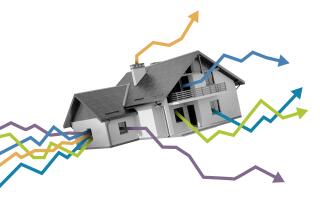Gloom WITH A View : Slow Torment in a Slow Housing Market
- Share via
NORTHRIDGE — Each time he approaches his dream house on the hill, Darrel Swendener sees the signs of his growing discontent.
First, outside the driveway is the for-sale sign that has perched like a vulture for more than two years--a warning that something is not quite right here. And the same clanking realtor’s lock box clings to his front door.
Inside, he and his wife, Carol, keep the house spotless--a necessity in the event of a realtor’s ambush at most any hour of the day or night. That means no dirty dishes, no half-filled coffee cups left on the table, no little unfinished projects.
Then there are the browsers with the white gloves and video cameras who wander through the bedrooms and bathrooms with their real estate agent guide, all of them asking nosy questions, making unfair assumptions, judging the Swendeners as much as they’re sizing up their house.
For a couple of years it has gone on, the ebb and flow of would-be buyers who always seem to find something wrong: The price is too high. There’s no swimming pool. Geez, the grass isn’t exactly the right color.
For the Swendeners, who bought the 2,730-square-foot home in 1989, the rejections are little insults that have become one big hurt.
“It’s like living in a model home--it’s just not ours anymore,” Carol, 57, says, sitting in the kitchen of the hillside Northridge home with a 280-degree panorama of the twinkling San Fernando Valley lights below, a view that some days can stretch for 50 miles or more.
“We watch them come and go, and you finally ask yourself, ‘What’s wrong with my house? I love this place.’ You finally decide that your house has a jinx, a little black cloud hovering overhead that chases people away.”
In January, that cloud rained more bad news: The couple suffered $60,000 in damages during the Northridge earthquake. They only placed their home back on the market in late June after Darrel spent months playing fix-it man.
Now the couple is watching the clock. Arthritis has forced both into early retirement. In a few months, they won’t be able to afford the mortgage on the house they thought they would own through retirement. Now there’s no choice but to let their dream home go.
The Swendeners are among thousands of anxious homeowners dragging an A-framed ball and chain--a house that refuses to sell.
While 1993 brought a modest rise in the number of homes sold in the Valley--the first rise in home sales in four years--realtors warn that the market remains soft.
Last year, according to statistics from the San Fernando Valley Assn. of Realtors, 10,506 homes and condominiums were sold locally, a 7.2% rise from 1992, which saw sales of 9,805. During the same period, however, the average price of a single-family home dropped 10.9%, from $283,386 to $252,633, representing the third year of decline.
And so far this year, sales of homes and condos in the Valley are up by 24%, but the average price of a single-family residence is down 11% from last year, to $231,283.
In 1988, a peak sales year, 19,714 single-family homes and condominiums were sold in the Valley. The average price of a single-family dwelling, excluding condos, was $248,492.
Such sobering statistics point to several factors at work in the market. For one, realtors say, banks are selling hundreds of houses at half the going rate in an effort to recoup investments on foreclosed homes.
“That’s one thing the homeowner has to deal with,” said Tom Morehouse, owner of Century 21 in Chatsworth. “Banks have 20 or 30 properties to sell at once and they blow them all out with real low prices. It’s hard for the homeowner to compete.”
Many homeowners, especially those who bought their house during the 1980s boom and hoped for huge profits, are asking too much, market watchers say.
“The seller then blames the agent when his house doesn’t sell,” said Joe Andrews, owner of Century 21 All-Star Properties in Canoga Park. “They tell you, ‘Do something!’ But these people have to realize if their asking price is unrealistic to begin with, they’re not going to sell their home.”
Darrel Swendener says that argument makes his blood boil.
“The realtors aren’t making any money,” said the 58-year-old former Sears employee. “So they walk right in and say, ‘Drop the price.’ They’re only thinking of their commissions. Meanwhile, they’re driving the price of every house in the area down, down, down. There’s no bottom.”
After paying $340,000 for his house in 1989, Swendener put it on the market in 1992 for $579,950. Later, the price dropped to $470,000. Slowly, like the thermometer dropping on a cool autumn night, the asking price plummeted to its current level: $335,000.
“We were assured that if we dropped the price it would sell immediately,” Swendener said. “We followed instructions. And nobody even looked at the place!”
The Swendeners are no newcomers to the Southern California housing market. They made big profits on two previous homes. But with the Northridge house, Darrel says, they made one big mistake: They invested $100,000 in improvements, money they’ll probably never see again.
So they sit and wait. Then they can move to Oregon and settle in a more affordable community.
First, though, they have to endure the lookers.
Without knocking, one woman walked in on a naked Darrel as he showered. Another offered Carol cash--not for the house--but for the Christmas tree ornaments she had made by hand.
They have watched dumbfounded as Asian investors walk through the house speaking only Japanese, bowing as they walk out the door. Another man startled Darrel in the garage, holding the couple’s guard dog in his hands: “When your guard dog gets friendly, you know you’ve been invaded.”
One day, Darrel lost his cool when a man complained about the browning Bermuda grass in the back yard: “I just came unglued. I told both he and the realtor to leave. They obviously were not interested in the house. And I had taken all I could stand.”
But the end, they know, is coming.
One day, someone will make the right offer on their dream home. Then they’ll be free to go--with tears in their eyes.
“For years, it’s been like living with a cancer patient,” Darrel said. “There’s been a lot of pain. We want the end to come. But, when it does, we know it’s going to hurt even more.”
* MAIN STORY: A1
More to Read
Sign up for Essential California
The most important California stories and recommendations in your inbox every morning.
You may occasionally receive promotional content from the Los Angeles Times.






